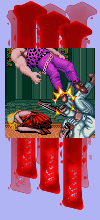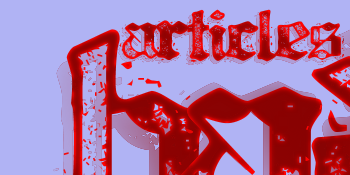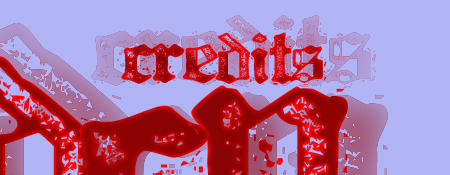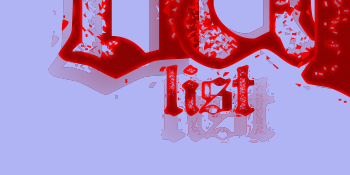

|

|
 |
 |
 |
Breakdown/Beatdown
Final Fight is probably my number one series
of all-time. I say probably because even with Street Fighter considered,
I probably love Final Fight more. It's a tough consideration because
they are essentially one in the same, and it's possible me and my friends
have spent more time with Street Fighter, overall, but nevertheless.
So, when my best friend first told me he got Final Fight for Christmas back
in the early 90's, I was hyped. A game we had spent so much on in arcades
was now in his home! I'll never forget what it was like seeing the game
outside of the arcade, in his room, on his TV. As soon as we walked down
to his room in the basement and opened his door, all the distinct sights
and sounds of Final Fight flooded the senses. It was just like at
the arcade! Everyone was piled in his room, gathered around the game in
awe, as Cody trashed scumbags on a subway train. It was insane! |
|
|
|
Two
For The Road
Of course, I was surprised when I noticed that only one of us could play
at a time, but the more I thought about it, the more I remembered the
burden of "friendly fire" when we played at arcades. That burden
was no more. Further, the game wouldn't always have a crowd around
it. Having everybody together was still
a blast, though, and the fun was never-ending because we didn't have to
worry about quarters. We could finally sink our teeth into the game and
get better at it. When my best friend told me Guy wasn't in the version
he had, my first impression was shock. He didn't really care much because
it seemed like he was a bigger fan of Cody and Haggar. I was a fan of
them all, but Guy was my favorite, so it was a great relief when Final
Fight Guy came out soon after. Back then, things weren't convenient
like they are now; we couldn't just download characters and/or updates.
|
|
|
| There
was no cheap and/or convenient downloadable content. Back then, we had to
foot the cost of not just one cartridge, but two cartridges
to play Final Fight with all three characters. We weren't complaining,
though, because it meant we had all three at our control, in the comfort
of our own homes. The incredibly frustrating Industrial Area stage was absent,
but who noticed? Not us; we could barely get past the second stage boss
Katana, let alone the third stage Andore blitz. When we did notice, however,
nothing (if anything) was lost. The journey of brutality and intensity was
intact with a host of welcome additions (like new story elements and items)
that gave us reason to play the game even more. It had reached an even bigger
audience with the consumer (Super Nintendo Entertainment System) revision
than in in arcade, and that was a good thing! |
|
|
"Fist
To Your Face"
I can remember clearly all the Summer days spent with this game, and if
it wasn't for my cousin getting it and then selling it to me, it wouldn't
gotten played Final Fight Guy for a long, long time. He knew
one of my dreams in life was to own it, so he knew how much it meant to
me. To this day, I am thankful for it, and wouldn't part with it for anything.
Its sentimental value far exceeds its value in rarity. Though it's awesome
to be able to tell people I got the game (and before eBay was around), nothing
that beats the nostalgic imagery when I hold it. Vivid memories of my cousin
(a "grown-ass man" now) flash before my mind's eye as a connection
to a past forever gone. I don't have many photos of us as kids, but I have
a cartridge that does more than a photo by bringing me back to the days
we'd sit on the floor in front of this game for hours. He had the patience
of a saint. |
|
|
|
Here
in the present, all you hear is self-proclaimed "fans" like
"Rage Quitter 87" talk about what Final Fight lost in
the transition from arcade to consumer, but so little about what it gained
in the transition. This point is rarely (if ever) discussed in depth.
To undo the ruin of uneducated reviewing, the SNES home version(s) shouldn't
be addressed as mere "ports" of the arcade original, but a revision
with omissions as well as additions. Whether the additions make-up
for the omissions or not is ultimately up to personal preference. Rest-assured,
though, from new items and enemies, to redrawn visuals and alternate endings,
the additions are there.
|
|
|
|
Every review you read
about the game will copy every other review and slam the SNES revision(s)
of Final Fight for being single-player. It's nothing new that "fans"
lack the capacity to write anything different about a classic than
what has already been written about it for years. Multi-player
omission is an unfortunate truth, but in no way does it render the rest
of the game nonexistent. Even without multi-player, it's a masterpiece
in design and still one of the best games ever made! Most of us who played
the arcade original never got to experience the single-player aspect of
the game (because it was always so crowded), and it's not like you'll
always have a second player to join you at home, anyway (especially today
when so many players go it alone even in multi-player games). They say
there's a silver lining to everything.
The Industrial
Area stage was missing, and is considered to be a glaring omission by
copycats everywhere, but few really think deeper than that. Yes, it's
probably cooler than the Bay Area stage, but was it really fun?
With flares coming out of the ground and enemies at their height of cheapness,
hardly. Does anybody remember actually playing this stage back
in the day at arcades when it took money to play? It was annoying as hell.
There were more environmental threats in the arcade original with it intact,
so its omission from the consumer revision(s) changed the gameplay to
more emphasis on fighting and less on hazards. That's fine by us players
who don't like environmental hazards to begin with; the stage looked cool
on some parts, but you couldn't really enjoy it because it seemed more
like a chore than anything. Speculation exists as to why the stage was
omitted, but the silver lining here is that Capcom inadvertently balanced
the game out, making it more fun and approachable than the raw arcade
original. In actuality, they inadvertently did same thing with the home
revision of SFII!
|
|
|
|
"What
You See Is What You Get"
On the same subject, one of the things that made the arcade original raw
was its unapologetic, gritty visuals. The seedy underworld of Metro City
was faithfully carried-over in the SNES home revision(s), complete with
redrawn portions and alterations. The streets of Metro City still look
mean, but you'll notice parts that looked a bit grimy and tacky in the
arcade original look cleaner and more solid. The basement in the slums
and subway ride portions are the most noticeable, and it really was for
the better. I, for one, am glad the flickering light effect in the basement
area from the arcade version was omitted because it was fucking annoying.
The subway no longer has swaying handles hanging from the ceiling, but
it's no real loss, and probably gave people vertigo, anyway. Thankfully,
the chandeliers in the final stages were also changed in the home revision(s);
they were easily mistaken as the potroast power-up in the arcade original.
|
|
|
| Speaking
of items, there were more in the arcade original (if memory serves me right),
but the cool thing about the home revision(s) is that it swaps old ones
like beer and steak for new ones that include turkey, a Jessica icon,
and Guy icon. The Guy icon that grants an extra life seems like it would
be a show-stealer, but the real game-changer here is the Jessica icon that
grants invincibility. The Guy icon is basically a stackable item, though,
so you can get a few in a single playthrough if you're lucky, then still
get extra lives from points on top of that! This is yet another aspect of
the home revision's wider appeal. And though some argue the reasons behind
it, old enemies were even swapped-out for new ones; American players got
to beat-up male punk-rockers Billy and Sid in place of the infamous Poison
and Roxy. Circumstances, speculation, and substitution aside, Billy and
Sid were not in the arcade original, and thus should be treated as the new
characters they are. Again, the silver lining here is that the American
revision(s) was released after the Japanese revision(s), and with extra
characters; they may not be much to some, but the exclusive content was
something American players should be thankful for, nonetheless. I know I
was! |
|
|
| All of the
above changes in mind, gameplay changes were inevitable. Lessened emphasis
on environmental hazards and added items played a part, but the game felt
slightly different as a whole. Between the two, it seemed like the home
revision(s) had been refined. Game difficulty was better paced in enemy
quantity, placement, and attacks. Enemies run in smaller groups that probably
helped mass-appeal bum-rushing legions; like they say, "two's a crowd,
three's a party," and that's what you'll see. Of course, you'll still
be attacked with the standard punches and kicks from the likes of thugs
like Doug, along with cheap shit like knives and slides from El Gado, but
Simons' cheap jump kick didn't make it into the home revision(s); it was
with good reason, though, and it's likely nobody thought it was any sort
of great loss. Of course, Guy, Cody, and Haggar's moves all made it in,
from the alternate air moves and grabs, to the crushing wrestling moves
and punishing combos. Hit collision just feels better all-around in the
SNES home revision(s), too; missed-attack frequency is lower, and Andore
seems easier to escape if you're unfortunate-enough to get grabbed. As a
whole, Andore's attacks just seem more fair and escapable than in the arcade
original. More proof against the SNES home revision(s) being "ports"
is the fact that Guy has a unique ending not found in the original arcade
version; unbeknownst to many, but definitely worth playing through again
for fans. |
|
|
Sounds
Of The Streets
Audio is the least controversial part of the game. The arcade version's
gritty soundtrack laid the foundation for the remixed SNES consumer version(s)
soundtrack, which is for me, personally, the most memorable video game music
of all time. It perfectly conveys the game's theme of urgency as you race
against time plowing through the Mad Gear Gang to save the girl. A great
example is the Bay Area stage, where the music calms when the stage is relaxed,
and gets you pumped when the stage picks-up. Even after all these years,
the Andore cage fight in the third stage and palm tree area of the last
stage are my two favorites. To this day I can still remember each note of
each song to a T. Each area's song fits its theme perfectly, and they're
all just as memorable as (if not more than) everything in Street Fighter
II - The World Warrior! Sound effects were also remixed; the sword and
pipe sounds are gone, but the knife retains its sound, Guy has a new voice,
and enemies somehow find the energy to scream out, "quaaaaa" (instead
of a muffled grunt) before they die-off. Nobody can deny that all the belts,
thuds, smashes, smacks, deaths, and extra lives are delivered with the essential
sound cue distinction and clarity so that the player knows what's going
on at all times. |
|
|
Quartered
The arcade original Final Fight was huge, so it was unbelievable
back then to even be able to play it outside of the arcade, let alone the
most current revision(s) of it. It's probably next to impossible for those
not around back then to understand what it was like. The feeling of being
thankful for not having to wait in line to play and/or pump handfuls of
quarters into the game. The arcade original was already mysterious-enough
(since playing through the game when someone's "got next"
was virtually-impossible), and Capcom put more into that with the inclusions
of the home revision(s). Being able to play through the game yourself was
a huge draw in filling in all the blanks from visits to the arcade. |
|
-
BAD
|
|
|